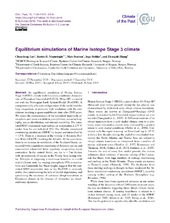| dc.contributor.author | Guo, Chuncheng | |
| dc.contributor.author | Nisancioglu, Kerim Hestnes | |
| dc.contributor.author | Bentsen, Mats | |
| dc.contributor.author | Bethke, Ingo | |
| dc.contributor.author | Zhang, Zhongshi | |
| dc.date.accessioned | 2020-02-17T13:30:35Z | |
| dc.date.available | 2020-02-17T13:30:35Z | |
| dc.date.issued | 2019-06-26 | |
| dc.Published | Guo C, Nisancioglu KH, Bentsen M, Bethke I, Zhang Z. Equilibrium simulations of Marine Isotope Stage 3 climate. Climate of the Past. 2019;15(3):1133-1151. | eng |
| dc.identifier.issn | 1814-9332 | en_US |
| dc.identifier.issn | 1814-9324 | en_US |
| dc.identifier.uri | https://hdl.handle.net/1956/21425 | |
| dc.description.abstract | An equilibrium simulation of Marine Isotope Stage 3 (MIS3) climate with boundary conditions characteristic of Greenland Interstadial 8 (GI-8; 38 kyr BP) is carried out with the Norwegian Earth System Model (NorESM). A computationally efficient configuration of the model enables long integrations at relatively high resolution, with the simulations reaching a quasi-equilibrium state after 2500 years. We assess the characteristics of the simulated large-scale atmosphere and ocean circulation, precipitation, ocean hydrography, sea ice distribution, and internal variability. The simulated MIS3 interstadial near-surface air temperature is 2.9 ∘C cooler than the pre-industrial (PI). The Atlantic meridional overturning circulation (AMOC) is deeper and intensified by ∼13 %. There is a decrease in the volume of Antarctic Bottom Water (AABW) reaching the Atlantic. At the same time, there is an increase in ventilation of the Southern Ocean, associated with a significant expansion of Antarctic sea ice and concomitant intensified brine rejection, invigorating ocean convection. In the central Arctic, sea ice is ∼2 m thicker, with an expansion of sea ice in the Nordic Seas during winter. Attempts at triggering a non-linear transition to a cold stadial climate state, by varying atmospheric CO2 concentrations and Laurentide Ice Sheet height, suggest that the simulated MIS3 interstadial state in the NorESM is relatively stable, thus underscoring the role of model dependency, and questioning the existence of unforced abrupt transitions in Greenland climate in the absence of interactive ice sheet–meltwater dynamics. | en_US |
| dc.language.iso | eng | eng |
| dc.publisher | European Geosciences Union (EGU) | en_US |
| dc.rights | Attribution CC BY 4.0 | eng |
| dc.rights.uri | http://creativecommons.org/licenses/by/4.0/ | eng |
| dc.title | Equilibrium simulations of Marine Isotope Stage 3 climate | en_US |
| dc.type | Peer reviewed | |
| dc.type | Journal article | |
| dc.date.updated | 2019-10-24T07:34:39Z | |
| dc.description.version | publishedVersion | en_US |
| dc.rights.holder | Copyright 2019 The Author(s) | en_US |
| dc.identifier.doi | https://doi.org/10.5194/cp-15-1133-2019 | |
| dc.identifier.cristin | 1721578 | |
| dc.source.journal | Climate of the Past | |
| dc.relation.project | Notur/NorStore: NN4659K | |
| dc.relation.project | EC/FP7: 610055 | |
| dc.relation.project | Norges forskningsråd: 246929 | |

